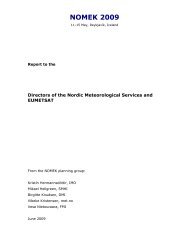International Symposium on Mitigative Measures against Snow ...
International Symposium on Mitigative Measures against Snow ...
International Symposium on Mitigative Measures against Snow ...
You also want an ePaper? Increase the reach of your titles
YUMPU automatically turns print PDFs into web optimized ePapers that Google loves.
<str<strong>on</strong>g>Internati<strong>on</strong>al</str<strong>on</strong>g> <str<strong>on</strong>g>Symposium</str<strong>on</strong>g> <strong>on</strong> <strong>Mitigative</strong> <strong>Measures</strong> <strong>against</strong> <strong>Snow</strong> Avalanches<br />
Egilsstaðir, Iceland, March 11–14, 2008<br />
trajectory of a point mass <strong>on</strong> the upstream facing sloping side of the dam. A fundamental problem<br />
with the point mass view of the impact of an avalanche with a deflecting dam is caused by the<br />
transverse width of the avalanche, which is ignored in the point mass descripti<strong>on</strong>. As a c<strong>on</strong>sequence<br />
of this simplificati<strong>on</strong>, the lateral and l<strong>on</strong>gitudinal interacti<strong>on</strong>s between different parts of<br />
the avalanche are ignored. Point mass trajectories corresp<strong>on</strong>ding to different lateral parts of an<br />
avalanche that is deflected by a deflecting dam must intersect as already deflected material <strong>on</strong> its<br />
way down the dam side collides with material heading towards the dam farther downstream.<br />
Similarly, it is clearly not realistic to c<strong>on</strong>sider the flow of snow in the interior of an avalanche<br />
that hits a catching dam without taking into account the snow near the fr<strong>on</strong>t that has already<br />
been stopped by the dam. The effect of this interacti<strong>on</strong> <strong>on</strong> the run-up cannot be studied based <strong>on</strong><br />
point mass c<strong>on</strong>siderati<strong>on</strong>s and a more complete physical descripti<strong>on</strong> of lateral and l<strong>on</strong>gitudinal<br />
interacti<strong>on</strong>s within the avalanche body during impact with an obstacle must be developed.<br />
Figure 1 A catching dam at Brún in Bjólfur in Seyðisfjörður, eastern Iceland. An avalanche<br />
that fell <strong>on</strong> the 9 th of February 2008 and stopped <strong>on</strong> the dam face can be seen. The<br />
dam is 20 m high with a 10 m high very steep upper part. (Photo: Emil Tómass<strong>on</strong>.)<br />
2. DAM HEIGHT DETERMINATION<br />
New dam height criteria have been developed based <strong>on</strong> the c<strong>on</strong>cepts of supercritical overflow<br />
and flow depth downstream of a shock (Hák<strong>on</strong>ardóttir, 2004; Hák<strong>on</strong>ardóttir and Hogg, 2005;<br />
Jóhanness<strong>on</strong> and others, 2008a,b). A dry-snow avalanche will typically flow towards a dam in<br />
a supercritical state, that is with a Froude number greater than 1 (or perhaps greater than some<br />
other limit larger than 1, depending <strong>on</strong> the rheology). The first determining factor for the<br />
height of both catching and deflecting dams is, that uninterrupted, supercritical flow over the<br />
dam must be prevented. If supercritical overflow is impossible, shallow fluid dynamics predicts<br />
the formati<strong>on</strong> of a shock upstream of the dam. This theoretical predicti<strong>on</strong> has been c<strong>on</strong>firmed<br />
for fluid and granular flow in several chute experiments, and may have been observed<br />
in natural snow avalanches. The sec<strong>on</strong>d criterium for the design height of avalanche dams is,<br />
that the flow depth downstream of the shock must be smaller than the dam height. These two<br />
requirements in combinati<strong>on</strong> c<strong>on</strong>stitute the main part of the new design requirements. Furthermore,<br />
the estimated snow depth at the locati<strong>on</strong> of the dam is to be added to the dam height.<br />
Figure 2 shows the dam height as determined from the new dam design procedure for a dam<br />
with side slope 1:1.5, corresp<strong>on</strong>ding to loose materials.<br />
Jóhanness<strong>on</strong> and others 201











